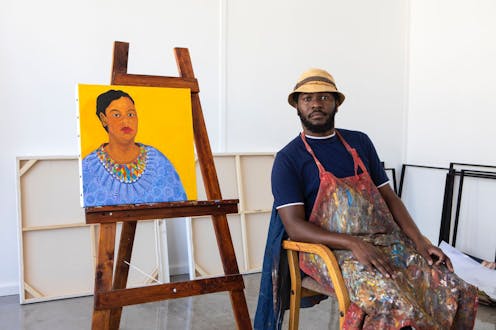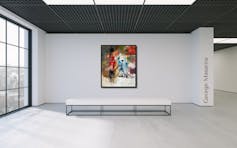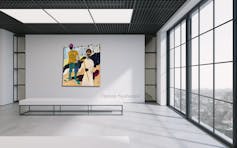
In the past 20 years, a new generation of Zimbabwean artists has attained international acclaim, or emerged as stars with work showing at top galleries and museums, collected by prominent people such as Jay Z. One of these stars, Cape Town based Richard Mudariki, is now using his growing fame and network to create a contemporary art fair to spotlight emerging artists in Zimbabwe. With it Harare has joined other major African cities like Cape Town, Dakar, Lagos, Marrakech and Kampala in bolstering its contemporary art scene.
Mudariki co-founded artHARARE Contemporary Art Fair with art historian Aya Koudounaris. The first editions in 2020 and 2021 took place online in a time of COVID isolation. Now it’s expanding its scope by fundraising to take place in physical form in Harare sometime in November 2022.
While fairs are marketplaces where various galleries display art for sale in order to attract collectors, artHARARE is also driven by a sense of community building. It is addressing a lack of infrastructure that continues to force young talent to look elsewhere for support. I spoke with Mudariki about the project.
Who attends or views artHARARE, from where?
Because of the power of the internet, our growing audiences for the two editions of artHARARE were international. According to the website analytics and reports, we have a huge following from South Africa, Germany, the UK, the US and of course Zimbabwe. Most visitors (87%) came to our site directly, not from a link from another site, while 47% came through Google and 16% through our social media platforms. The majority of our audience are art collectors, curators, art institutions, journalists, art historians, art lovers, art students and artists.
What kind of model is artHARARE built on?
The model that artHARARE has adopted is unique in that it is an artist-run contemporary art fair. Artists are our key partners in this venture. Our value proposition is to bring under one umbrella and celebrate all leading contemporary Zimbabwean visual arts and cultural producers in an open, easy to view platform. Our mission is to attract the attention of leading international art collectors, art museums, art foundations, auction houses and corporate collections to acquire and add contemporary Zimbabwean visual art to their collections.

Over the past 18 months artHARARE has received tremendous support from the artistic community in Zimbabwe and its diaspora. The platform aims to deliver economic value to both the artist and the collector or art institution by being the go-to platform to showcase and discover art, explore Zimbabwe’s rich artistic heritage and establish competitive primary and secondary market prices.
We are heavily investing in building a robust network of artists, curators, collectors, galleries, art dealers, art historians, and art lovers, a form of social capital, or call it cultural capital. As an entrepreneurial venture, we have a time horizon of five years to develop the brand artHARARE, realise our vision and place it on the international art calendar.

In our launch year, we saw significant contributions of skill, energy and time by many art professionals in Zimbabwe and in its diaspora, and a dedicated team that worked to launch the online fair in just under four months. A lot of value was created, with many artworks by emerging Zimbabwean visual artists being acquired in local and international private collections. In addition, a number of emerging artists who were showcased in the fair were picked up by international galleries in London and Milan.
Year two saw an increased interest in the activities of the fair both from the artists (more than 30) and art collectors representing all continents. We were privileged to showcase artworks of internationally recognised Zimbabwean artists such as Moffat Takadiwa and Portia Zvavahera. Their participation allows for the fair to have anchor artists that give it weight. The fair’s art prize was established and we facilitated a programme that brought an emerging female artist Prudence Chimutuwah from Harare to a four week residency in Cape Town.
Why did you feel an art prize was a necessary intervention?
The artHARARE Africa First Art Prize was set up to benefit emerging and mid-career artists working in Zimbabwe and the Zimbabwean diaspora by increasing their profile. For the inaugural prize, we received a number of high quality submissions and the professional jury team – Fadzai Muchemwa, Moffat Takadiwa, Marwan Zakhem, Serge Tiroche and Richard Mudariki – had a hard time picking the two winners Wilfred Timire and Franklyn Dzingai. A group exhibition of the shortlisted artists was held.
Read more: How Zimbabwean artist Kudzanai Chiurai has reinvented the idea of a library
It will be run as an annual prize. The sponsors, Africa First founded by art investment expert Serge Tiroche, share our vision of promoting contemporary art from the continent.
What have you learnt so far?
I have learnt these important lessons:
Opportunities exist in the midst of a crisis.
Working with an energetic, committed and hardworking team makes a difference.
Zimbabwe is full of fresh talent and the artists are eager to be successful.
We need to work together and speak as one voice.
The digital renaissance in the global art market is here to stay.
In future will you change any aspects of the fair?
Going forward, the fair will have a physical presence which seeks to activate various spaces in the city (and country) to host creative and artistic interventions. An art education programme is also on the plans to educate and encourage a new generation of young local art lovers and art collectors. This will also be complemented by an artist incubation programme that seeks to develop artists to become professional in their practices.
Tinashe Mushakavanhu does not work for, consult, own shares in or receive funding from any company or organisation that would benefit from this article, and has disclosed no relevant affiliations beyond their academic appointment.
This article was originally published on The Conversation. Read the original article.







